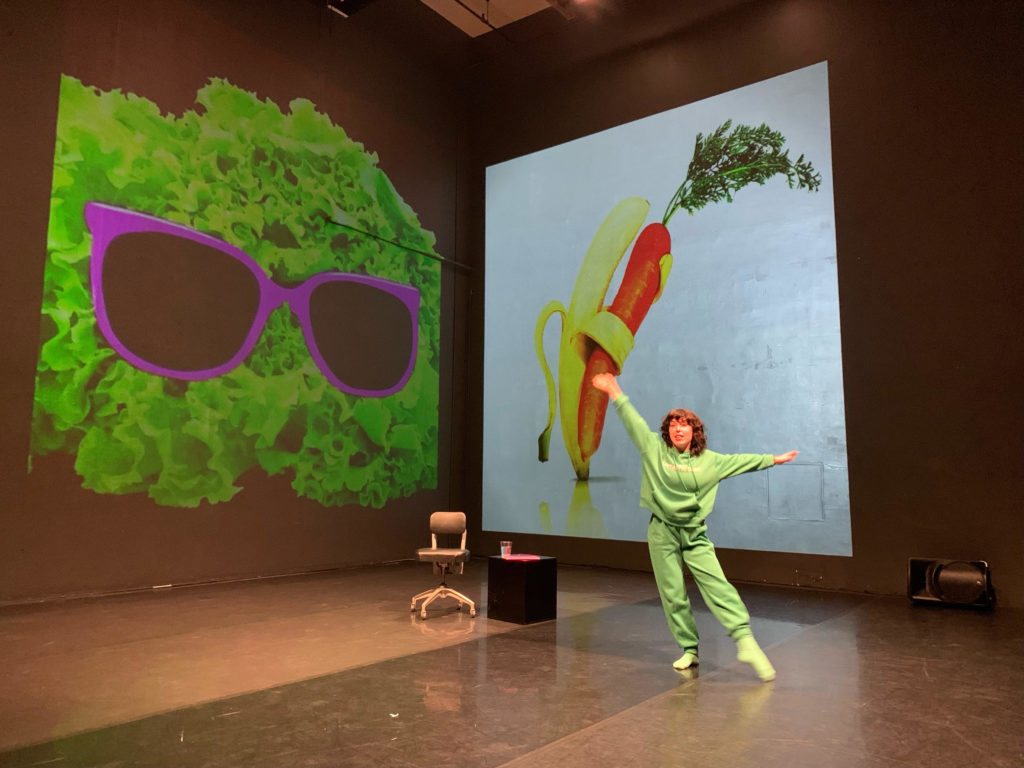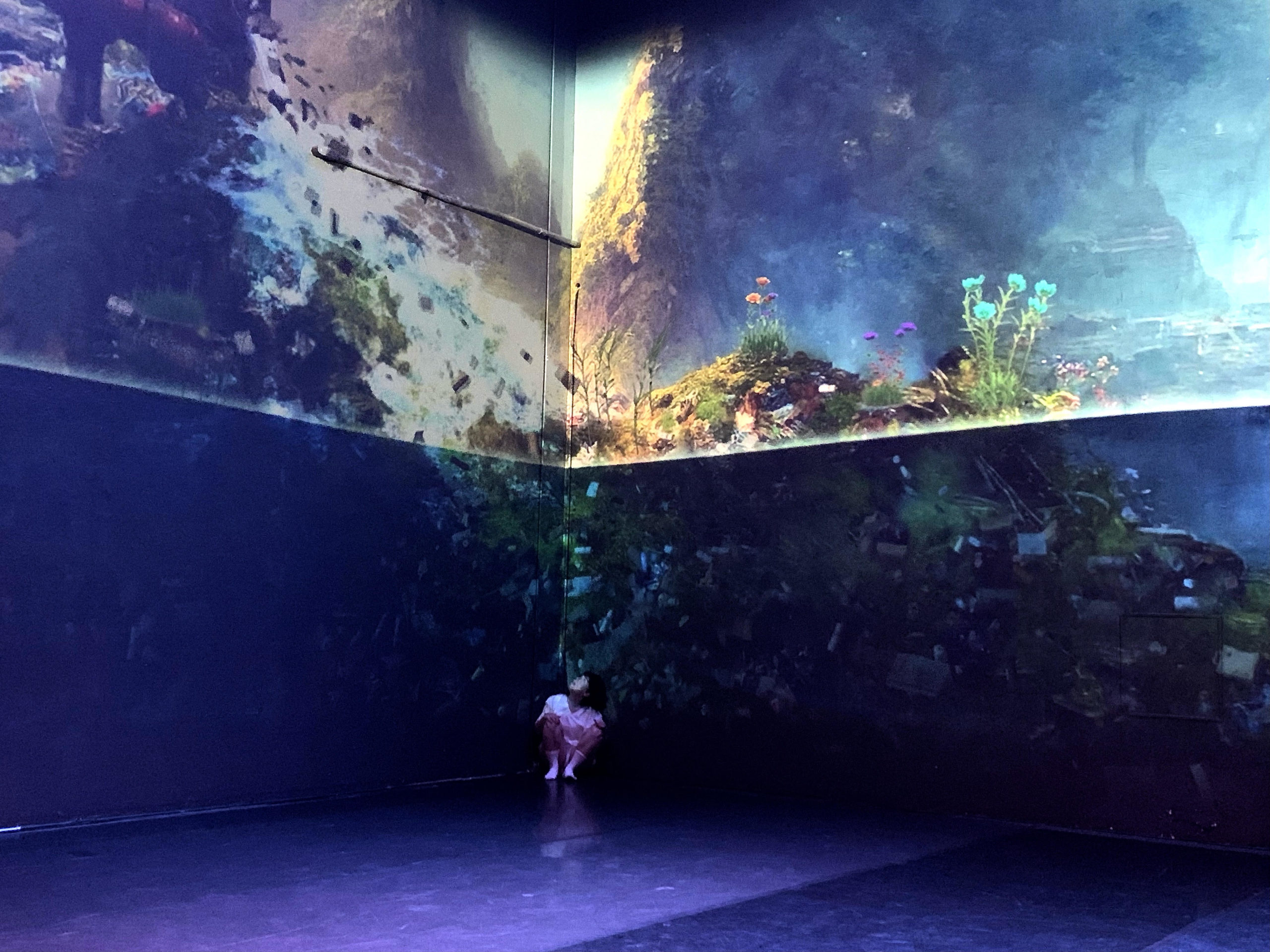Edited Transcript by Maxine Flasher-Düzgünes.
Annie Kahane is a performer and maker working in performance poetry, dance, song, and theater. She founded Alive & Well Productions in 2014 to unify these disciplines under a single creative umbrella. Her performance works have been supported by the San Francisco International Arts Festival, New Music USA, the Zellerbach Family Foundation, ODC Theater and the Kenneth Rainin Foundation. Her poetry has been featured on KQED San Francisco Public Radio and WBEZ Chicago Public Radio. She currently teaches as a Lecturer at UCLA’s school of World Arts & Cultures/Dance.
Maxine: Can you speak about what the process was like making “Meeting #7” for the San Francisco International Arts Festival (SFIAF) last summer?
Annie: I had a poem I had been playing with in lockdown around the time of George Floyd, and just a moment in that 2020 – wow things are really dark – fever pitch. And I was writing this comic relief piece for myself to digest it, and it was called “Transcript of Support Call for Extraterrestrial Immigrating to Earth.” It was five minutes long and I forgot about it.
Then, when SFIAF approached me (in 2022) about sharing something, I wanted to bring a group piece that I made in LA but it was too complicated and expensive. I thought here’s my opportunity to make a solo, which I hadn’t done before. I’ve wanted to do something where I get to use the skills that I have in one piece – which I don’t always do when I’m working with an ensemble because, obviously, people come to the room with different things. But I have a bunch of acting training, also I’m a writer, and I have this experience in my day job of working with multimedia, and I’m still a mover. So the process started with the form: ‘it’s going to be a one-woman show.’
And then I thought, often a solo show is very confessional and very much about the artist’s autobiography, and I didn’t want to do that. I’ve done a lot of that and I’m more interested in things that are going to touch more people right now…I wanted to do something that had more gravity than just my personal experience. And then I remembered that I had this poem, and I thought what if I just blew that up into a whole show. What would that look like?
Then I had this idea of what if it’s a PowerPoint? I knew I was programmed at the Joe Goode Annex – I’ve always wanted to make something that was customised for those walls. I had this idea that there’s an orientation leader who’s giving a PowerPoint presentation, so I knew there would be slides to project onto the walls. The presentation format became a way for me to talk about the volume of messed up things that are happening and sort of digest them myself but in a way that’s not too preachy – that’s like silly but welcoming but dark.

The process went: ‘write a chunk, stage a chunk, write a chunk, stage a chunk’. Then halfway through that process I realised, something needs to happen in this show. It can’t just be the same quality of material the whole time. There has to be some narrative change. What happens if that narrative change is the veil dropping? And we get to see this character’s confusion and sadness about what it means to be alive on earth and feel helpless about all these tragedies?
But then I didn’t want it to end on a heavy note, so that’s where that final animation sequence came in. I read a lot of adrienne maree brown’s work, and they talk about the power of imagination and how one of the most radical things a person can do is imagine an alternative world.
So, what would it mean at the end of this piece that’s talking about these heavy topics, to try to dream into alternative possibilities? And how would I do that in a way that wasn’t super hitting the audience over the head?
So that’s where I came up with these animations, which was in collaboration with someone I know who’s a very high level video designer. The final “scene” of the piece became a series of suggestive, almost aspirational images of possibility and redemption. We made those images with AI – so we used text-to-image generators and then he manipulated them and layered them and animated them. So for example, in one section of the piece I’m talking about people who don’t have a place to sleep, sleeping in public. What would an image be that is evocative of sleeping in public but isn’t too didactic? And so then I would plug in “city park benches in an impressionistic style” and the AI image would come, and then he would manipulate it. And then I interacted with those animations.
Maxine: What was your intention in bringing this piece to audiences in San Francisco?
Annie: It’s funny you say that because I didn’t get this grant but I wrote a grant talking about wanting to do it specifically in San Francisco because a lot of problems are so concentrated there because it’s so small. And even though those problems exist everywhere, there’s really no hiding them in San Francisco, or the Bay Area at large. I think about this in Berkeley too, you know, like you’re walking by a beautiful Victorian home that has a two-car garage and then on the next street there are people sleeping outside. And the people in that home are probably academics who have “liberal politics”, but still somehow there’s this missing piece of personal responsibility.
Maxine: There were some really impactful images in that performance, especially the projected video of your dance with the bench designed to have those separations to discourage people from sleeping on it…
Annie: I didn’t really mean for the piece to be so much about homelessness but I think that that issue is such an obvious example of where we come up against our values and reality. Can our values meet reality in a way that’s going to have an impact? Because that’s where I feel the most struggle with my humanity…do I turn off that pain when I walk by someone who’s really struggling? Do I not turn off that pain and feel it?

Maxine: What role does poetry play in your artistic work?
Annie: The balance between movement and language has always been pretty even. And it’s taken a lot of forms: it’s been my writing, it’s been generated by the performers through prompts, it’s been existing texts published by other people. And I feel like my expressive capacity is even more in the realm of language than in the realm of movement.. And it plays different roles – sometimes the role it plays is a way to generate movement, like starting from poetry and working with the rhythm of the syllables and mapping that onto movement, or the images as a way to generate, or even just the aural, like what does it mean to be in the sound of “o”? And sometimes it’s a way of creating a connection with the audience and reducing abstraction because that’s just very central to how I think about making live performance. And I think that that’s not always the case. A lot of times contemporary performance emphasises this abstraction and that can be hard for the audience – if they’re not educated in that way – to connect to. And language is more universal. So speaking onstage is a way for the audience to enter the world, for them to understand it. The last thing I’ll say is that [language] solves this feeling I’ve had of not quite fitting anywhere. I’ve never quite felt that I’ve fit as a dancer. I’ve participated in spoken word communities when I was a teenager and in college and never quite felt that I fit there. Then I studied poetry in college in this very academic way and didn’t really feel like I fit there. I went to a performing arts high school for theatre, didn’t really feel like I fit there. So combining them in a way that feels true to my instincts is a solution to that.
Maxine: I feel the same, recently I’ve been involved and then not involved, sort of going into the little nooks and crannies of the industry but not feeling the big picture of it…
Annie: It’s a tricky spot, because there are ways that the industry rewards sameness. Like you’re doing the same thing so they understand what you’re doing and it’s rewarded, but then there’s also something really powerful about having your own voice and being like ‘this is what I have to contribute.’
Maxine: How as a performing artist do you want to engage with the dance community right now?
Annie: My main interest is making things that strike people with the same immediacy of a movie or a favorite song. Without throwing away fine art aesthetics, I’m interested in doing things that are super relational with the audience. And that doesn’t necessarily mean audience participation, it just means, I want people to watch the work and have a clear, felt experience that probably includes understanding some of what it was about. I wrote my whole master’s thesis paper about this, about the number of times I’ve heard non-dancers say “I didn’t get it” or “was it about that?” or “I was bored” and for me the point is that relationship.
Maxine: Oftentimes as dancers we approach the performance like we’re doing it for us, and that’s true, but when the audience comes around there’s this whole side that’s not considered.
Annie: The more I think about this, there’s nothing wrong with an artist making something for personal catharsis or making something to explore an intellectual idea, that’s fine, that’s a choice, that’s just not a choice I’m interested in right now. What’s the point of sharing it if it’s not meant to create an exchange?
Maxine: What are you working on right now?
Annie: A new piece that will premiere in January 2025 in LA. It’s for a solo dancer and solo violinist and it’s a collaboration with this young composer Kian Ravaei. It was funded by New Music USA which is super cool because I’ve never had work funded by a national grant before!
To learn more about Annie’s work, visit www.aliveandwellproductions.org or follow @alive_and_well_productions on Instagram.
